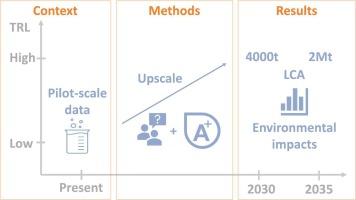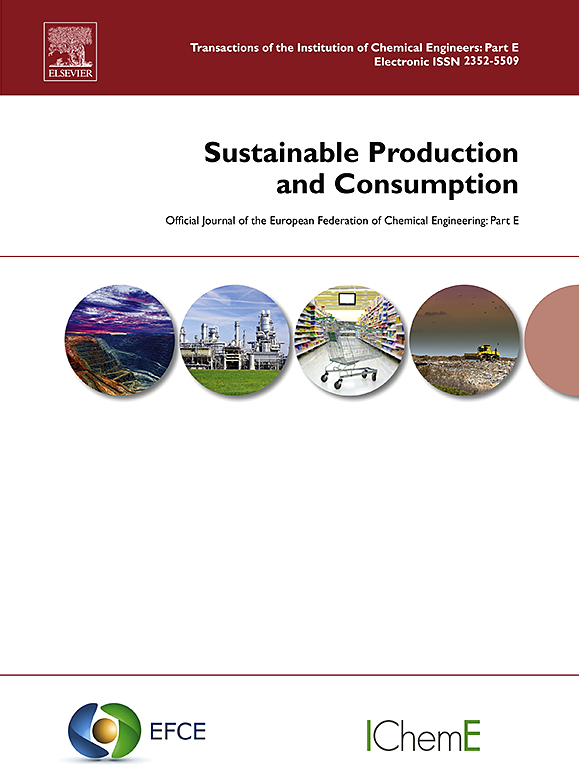基于褐海藻的生物塑料的前瞻性生命周期评估:从试验规模到工业规模的提升
IF 10.9
1区 环境科学与生态学
Q1 ENVIRONMENTAL STUDIES
引用次数: 0
摘要
海藻基生物塑料因其潜在的环境优势,被认为是传统化石基塑料的可能替代品。海藻种植生长迅速,不需要耕地、淡水或肥料,因此被视为生物资源生产的有利选择。然而,有关海藻类生物塑料对环境影响的研究仍然有限,这突出表明有必要进行生命周期评估(LCA),以评估其潜力。本文进行了前瞻性生命周期评估,以评估棕色海藻基生物塑料生产从中试到工业化生产的环境影响。在每个生命周期阶段都采用了扩大规模技术,利用访谈来扩大海藻生产规模,并对生物炼制和薄膜制造步骤进行过程模拟,同时将生命末期情景模拟为堆肥。所有工艺的规模在 2030 年达到每年 4000 吨,在 2035 年达到每年 200 万吨,其中包括棕色海藻的边际供应商。结果表明,在表现最佳的情况下,生产 1 千克褐藻基生物塑料产生的二氧化碳当量约为 1.37 千克,考虑到碳吸收,2035 年的年产量为 200 万吨,低于低密度聚乙烯(LDPE)产生的 3.6 千克二氧化碳当量。在 200 万吨情景下,对海洋富营养化的影响为-0.009 千克氮当量,对淡水富营养化的影响为-0.002 千克磷当量。本研究首次对新兴的海藻类生物塑料的预期工业规模影响进行了估算,并展示了如何将不同的升级技术(即访谈和过程模拟)成功结合起来,对海藻类生物塑料进行预期生命周期评估。研究结果证明了海藻基生物塑料作为传统塑料的可持续替代品的潜力。本文章由计算机程序翻译,如有差异,请以英文原文为准。

Prospective LCA of brown seaweed-based bioplastic: Upscaling from pilot to industrial scale
Seaweed-based bioplastics are considered a possible alternative to conventional fossil-based plastics due to their potential environmental advantages. The cultivation of seaweed is a fast-growing practice that requires no arable land, freshwater, or fertilizers, perceiving it as an advantageous option for bioresource production. However, research on the environmental impacts of seaweed-based bioplastics is still limited, highlighting the need for a life cycle assessment (LCA) to evaluate their potential. In this article, a prospective LCA is conducted to assess the environmental impacts of brown seaweed-based bioplastic production, from pilot to industrial scale. Upscaling techniques are combined for each life-cycle stage, using interviews to upscale seaweed production and process simulation for the biorefinery and film fabrication steps, and the end-of-life scenario is modelled as composting. All the processes were upscaled to 4000 tonnes (t) per year in 2030 and 2 million tonnes (Mt) per year in 2035, including marginal suppliers of brown seaweed. The results show that the production of 1 kg of brown seaweed-based bioplastic resulted in approximately 1.37 kg CO2-eq. in the best-performing scenario, producing 2 Mt per year in 2035 accounting for the carbon uptake, which is lower than low-density polyethylene (LDPE) with an impact of 3.6 kg CO2-eq. The impact in marine eutrophication in the 2 Mt scenario is −0.009 kg N-eq., and −0.002 kg P-eq. in freshwater eutrophication. This study provides for the first time estimates of prospective industrial-scale impacts of the emerging seaweed-based bioplastic and shows how different upscaling techniques can be successfully combined, i.e., interviews and process simulation, to conduct a prospective LCA of seaweed-based bioplastics. The results demonstrate the potential of seaweed-based bioplastics as a sustainable alternative to conventional plastics.
求助全文
通过发布文献求助,成功后即可免费获取论文全文。
去求助
来源期刊

Sustainable Production and Consumption
Environmental Science-Environmental Engineering
CiteScore
17.40
自引率
7.40%
发文量
389
审稿时长
13 days
期刊介绍:
Sustainable production and consumption refers to the production and utilization of goods and services in a way that benefits society, is economically viable, and has minimal environmental impact throughout its entire lifespan. Our journal is dedicated to publishing top-notch interdisciplinary research and practical studies in this emerging field. We take a distinctive approach by examining the interplay between technology, consumption patterns, and policy to identify sustainable solutions for both production and consumption systems.
 求助内容:
求助内容: 应助结果提醒方式:
应助结果提醒方式:


